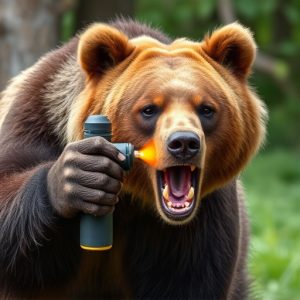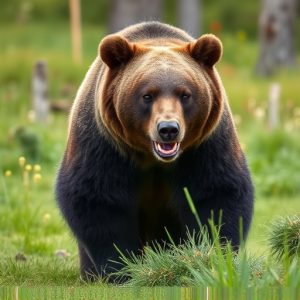Mastering Alaska Bear Spray Fog Pattern for Optimal Protection
Understanding the optimal distance for deploying bear spray (20-30 feet or 6-9 meters) is crucial fo…….
Understanding the optimal distance for deploying bear spray (20-30 feet or 6-9 meters) is crucial for safe and effective deterrence in Alaska's wild landscapes. Factors like wind, terrain, bear size, and spray concentration influence this range. Proper training, aiming low, using short bursts, and following manufacturer guidelines maximize the potency of bear spray against aggressive behavior without causing harm. Regular practice in simulated scenarios ensures users are prepared and confident to handle unexpected bear encounters.
Alaska’s rugged terrain demands a strategic approach to bear spray deployment. Understanding the fog pattern dynamics is crucial for effective self-defense. This article guides you through the intricacies of bear spray fog, exploring key factors influencing the optimal distance for application. We’ll delve into effective range, safety considerations, and training techniques to ensure your preparation aligns with the unique challenges presented by Alaska’s wild spaces, ultimately enhancing your survival capabilities.
- Understanding Bear Spray Fog Pattern Dynamics
- Key Factors Influencing Optimal Distance
- Effective Range and Application Techniques
- Safety Considerations for Spray Deployment
- Training and Practice for Optimal Performance
Understanding Bear Spray Fog Pattern Dynamics
Understanding the dynamics of bear spray fog pattern is crucial when venturing into Alaska’s wild landscapes. The optimal distance for bear spray deployment is a key consideration, as it dictates the effectiveness of self-defense. When sprayed correctly, the fog creates a protective barrier by dispersing capsaicin, the active ingredient in bear spray, into the air. This strategic cloud of peppery mist can deter aggressive bears from closing the gap between you and your safety.
The ideal range for effective use is typically around 20 to 30 feet (6-9 meters), but this can vary based on factors like wind direction, spray volume, and the size of the bear. Understanding how the fog pattern spreads and settles helps individuals make informed decisions in potentially dangerous encounters.
Key Factors Influencing Optimal Distance
When considering the optimal distance for bear spray, several key factors come into play. The primary concern is ensuring that the spray reaches the bear effectively while allowing for enough reaction time. The ideal range varies depending on various conditions, including terrain, wind speed and direction, and the size of the bear. For instance, in open areas with calm winds, the effective range can extend up to 30 feet (9 meters), providing ample space for a safe retreat. However, in rugged terrain or windy conditions, this distance may significantly decrease, emphasizing the need for caution and awareness.
Another crucial factor is the type of bear spray used and its concentration. Higher concentrations are more potent but may have shorter ranges due to their increased viscosity. Users should consult manufacturer guidelines for specific recommendations regarding optimal spraying distances. Additionally, training in proper usage and understanding the fog pattern’s behavior are essential skills for anyone venturing into bear country, ensuring a quick and effective response during encounters.
Effective Range and Application Techniques
In terms of the Optimal Distance for Bear Spray, understanding the fog pattern is key. Most bear spray cans project a fog or mist that can reach up to 30 feet (9 meters) in ideal conditions. However, factors like wind, temperature, and the sprayer’s technique can significantly impact this range. At closer ranges, around 5–10 feet (1.5–3 meters), the spray forms a dense cloud effective for immediate bear deterrence.
Application techniques play a crucial role in effectiveness. Aiming low, at the bear’s legs or paws, disrupts their balance and ability to escape or charge. Squirting the spray in short bursts as you back away can also enhance its reach and coverage area. Practice these application methods during training sessions to ensure they become second nature in an actual encounter, maximizing your safety and success when facing a bear.
Safety Considerations for Spray Deployment
When deploying bear spray, understanding the optimal distance is crucial for safety and effectiveness. The recommended range for spraying bears varies depending on factors like spray type and wind conditions, but generally, it’s best to keep a safe distance of 20-30 feet (6-9 meters). This allows for accurate application while maintaining a buffer zone that reduces risks associated with close encounters.
It’s important to remember that bear spray is designed as a deterrent, not a weapon. Aiming directly at the bear’s face or eyes can cause unnecessary harm and may provoke an aggressive response. Instead, target the bear’s body, specifically its face, to create a fog pattern that obscures vision and disorients the animal. Always follow manufacturer instructions regarding spray deployment techniques and be prepared to move quickly if needed during an encounter.
Training and Practice for Optimal Performance
Proper training and practice are essential for ensuring optimal performance with bear spray in Alaska. It’s crucial to learn the correct technique for spraying, including understanding the ideal distance to maintain for maximum effectiveness. The optimal distance for bear spray varies depending on factors like spray type, wind conditions, and terrain, but generally ranges between 20 to 30 feet (6 to 9 meters). Regular practice sessions should simulate real-life scenarios, focusing on how to accurately target bears while maintaining safety.
During training, individuals must learn the different modes of operation for bear spray devices—jet or puff—and understand when to use each. Practicing in various environments, from open fields to more confined spaces, helps in honing spraying skills. Additionally, understanding local regulations and safety protocols is vital. Regular reviews and refreshers can keep users prepared for unexpected encounters with bears, ensuring they are confident and capable of using bear spray effectively if needed.
Bear spray is a vital tool for personal safety in Alaska’s wild environments, but understanding its fog pattern dynamics is crucial. By optimizing the distance and employing effective application techniques, individuals can maximize the spray’s impact while minimizing risks. Safety considerations and proper training are essential to ensure successful deployment during encounters with bears. Knowing the optimal distance for bear spray usage, as discussed in this article, empowers outdoor enthusiasts and residents alike to protect themselves effectively in bear country.


